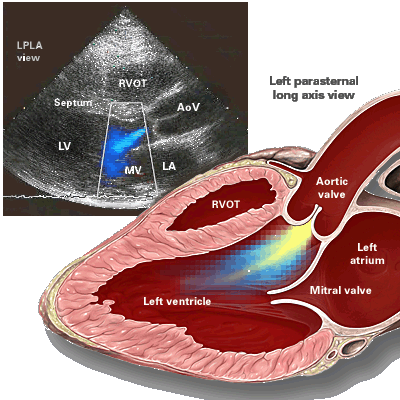Aortic regurgitation pathophysiology: Difference between revisions
No edit summary |
Varun Kumar (talk | contribs) |
(No difference)
| |
Revision as of 02:40, 22 March 2011

Editor-In-Chief: C. Michael Gibson, M.S., M.D. [1]
Associate Editor-In-Chief: Varun Kumar, M.B.B.S.; Lakshmi Gopalakrishnan, M.B.B.S.
Acute vs Chronic Causes
Acute Aortic Insufficiency
- After prosthetic valve surgery
- Aortic dissection
- Bacterial Endocarditis
- Chest trauma
- Myxomatous aortic valve
- Other valvular disease
- Rheumatic Fever
Chronic Aortic Insufficiency
- After prosthetic valve surgery
- Aortic Dissection
- Ankylosing Spondylitis
- Arteriosclerosis
- Bacterial Endocarditis
- Bechterew's Disease
- Bicuspid aortic valve
- Cystic medianecrosis of aorta
- Ehlers-Danlos Syndrome
- Hypertension
- Marfan Syndrome
- Myxomatous aortic valve
- Polymyalgia Rheumatica
- Pseudoxanthoma Elasticum
- Reiter's Syndrome
- Rheumatic Fever
- Rheumatoid Arthritis
- Sinus of Valsalva Aneurysm
- Syphilis
- Systemic Lupus Erythematosus
- Turner's Syndrome
- Ventricular Septal Defect
- Weight loss medications
Aortic Valve vs Aortic Root Causes
Aortic Valve Disease
A full list of causes of aortic regurgitation can be found on the page dedicated to the differential diagnosis.
One of the most common causes of aortic valvular disease in the past has been rheumatic fever in which case the aortic cusps are infiltrated with fibrous tissue. This then leads to retraction of the cusps and prevents their apposition during diastole. The cusps may also fuse and this may cause a component of aortic stenosis. It is therefore not uncommon for these patients to have mixed aortic regurgitation and aortic stenosis. Often these patients will have involvement of the mitral valve as well.
In the modern era, a more common cause of acquired aortic valve regurgitation is degenerative disease of the aorta and aortic valve in which case there is calcification and fibrosis of the cusps. As is the case with rheumatic fever, there is similar retraction of the cusps that results in aortic insufficiency.
A third not uncommon cause of acquired aortic regurgitation is infective endocarditis. In this disease state, regurgitation develops as a result of a hole or perforation that develops in the leaflet, or alternatively the cusps may not oppose each other due to a vegetation lying between the cusps which prevents their apposition.
A final not uncommon cause of acquired aortic insufficiency is trauma in which case there is distortion of the valve architecture leading to failure of the cusps to oppose.
Congenital conditions such as congenital bicuspid aortic stenosis or a ventricular septal defect can also result in aortic insufficiency.
Aortic Root Disease
Aortic root disease as a cause of aortic insufficiency has overtaken acquired forms of valvular disease and congenital forms of valvular disease as the leading cause of aortic regurgitation. The following is a list of those conditions that lead to dilation of the aortic root and thereby cause aortic insufficiency:
Hemodynamic Consequences of Aortic Insufficiency
Acute aortic insufficiency
Acute aortic insufficiency is often secondary to either trauma or infective endocarditis. While the heart can accommodate the changes of chronic aortic insufficiency over time, the acute changes of acute aortic insufficiency are not well accommodated by the left ventricle.
The rapid rise in left ventricular pressure causes the mitral valve to close earlier during diastole. This early closure fortunately prevents backwards flow of blood into the pulmonary vascular bed. The very high left ventricular end diastolic pressure often keeps the aortic diastolic pressure from falling too low and thus there is often not a wide pulse pressure. Indeed absence of a wide pulse pressure in the patient with acute aortic insufficiency should alert the clinician to potential failure of the left ventricle.
Chronic Aortic Regurgitation
The hemodynamic impact of aortic regurgitation is to cause progressive dilation and hypertrophy of the left ventricle. The mitral valve ring may also dilate which may lead in turn to mitral regurgitation. The left atrium may dilate as a result of the mitral regurgitation.
It has been said that 'aortic regurgitation begets aortic regurgitation'. The high oscillatory shear associated with aortic regurgitation may lead to further dilation of the aorta, which in turn may lead to further aortic regurgitation.
Volume overload associated with aortic regurgitation leads to left ventricular hypertrophy. The sarcomers replicate in series and there is elongation of the myocytes and myocardial fibrils. As a result of this hypertrophy the ratio of the ventricular wall thickness to cavity radius remains normal and therefore wall stress is normal. In aortic regurgitation there is eccentric hypertrophy where as in aortic stenosis there is concentric hypertrophy where there is replication of the sarcomers in parallel. Once wall thickening fails to keep up with the hemodynamic load, end systolic wall stress rises and at this point the left ventricle fails. The dramatic enlargement of the heart that is seen with aortic regurgitation is called cor bovinum. Over time the left ventricle will decompensate and there will be increasing interstitial fibrosis and a stiffening or a reduction in the compliance of the left ventricular wall. At this point the patient will experience a rise in the end diastolic pressure and volume. The first decline is seen with exercise and then the patient begins to have a reduction in forward output at rest.
Patients with chronic aortic insufficiency may also develop myocardial ischemia. This is due to the fact that they have an increase in demand due to an increased thickness of the LV and also a reduction in the supply due to a lower perfusion pressure during diastole.